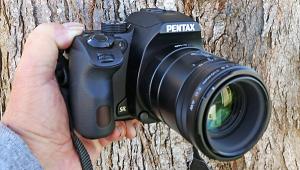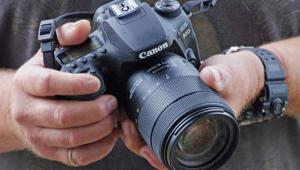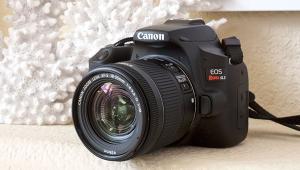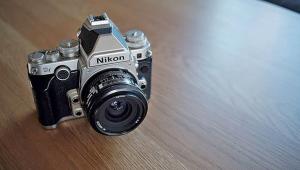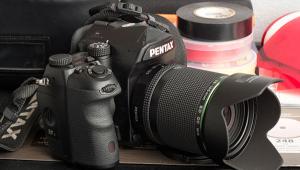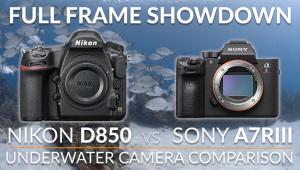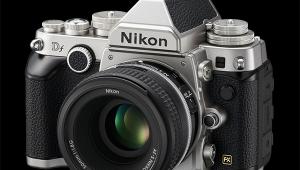Canon EOS 5DS DSLR Lab Review

(Editor's Note: Lab Review lab tests and comments are supplied by BetterNet, Shutterbug’s TIPA-affiliated testing lab and edited by George Schaub. Shutterbug is the sole US representative within TIPA, a worldwide association of photo and imaging magazines. Read our Field Review of the Canon 5DS with full resolution test images here.)
The new Canon EOS 5DS DSLR offers the first full-frame sensor camera with image resolution higher than 50MP. The camera is the successor of the Canon EOS 5D Mark III, which uses a 22MP sensor and was introduced in 2012. Canon offers the new EOS 5D series in two versions: the 5DS uses a standard low-pass filter to prevent moiré effects while the 5DS R uses a “low-pass filter cancellation” system, which means it doesn’t remove the filter from in front of the sensor but uses a filter system without a low-pass effect. We tested the “standard” EOS 5DS version.
Canon recommends only a few lenses for use with the 5DS. We received two lenses for our tests: the Canon EF 50mm f/1.8 II and the Canon EF 40mm f/2.8 STM. The resolution results with the 50mm lens were 200 lines higher than the 40mm, so we did all of our tests with the 50mm lens—with very good results. It should be noted that the EF 50mm f/1.8 II ($110) is a surprisingly affordable lens.

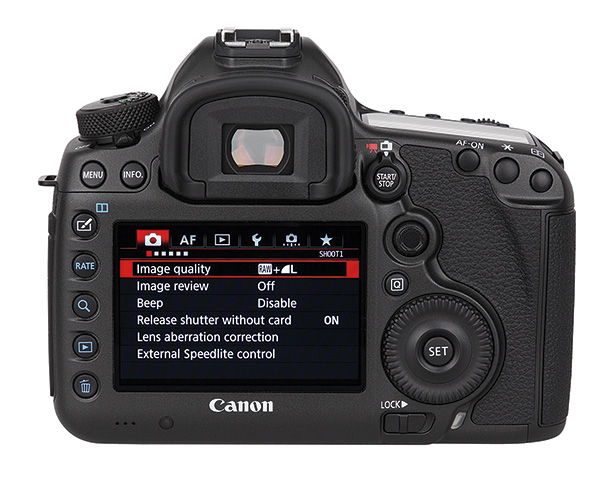


Camera Build, Layout & Performance
The Canon 5DS has a large body that is sealed to protect against dust and humidity. It offers a large status LCD on the top, which shows all important image parameters and camera status information such as battery status, remaining capacity on storage media, etc. The status LCD can be illuminated (by pressing a function button on the top) which allows the user to see all the information even in low-light scenes.
Setting up all parameters is very handy. The Canon 5DS offers a well-tried system with a very large setup dial on the back (with a SET or OK button in its center), a small joystick a little above the dial, and a second setup dial near the shutter release button. In combination with many function buttons on the back and the top, and with the mode dial to the left of the viewfinder prism, the camera affords very fast and intuitive setup of aperture, shutter speed, and all other parameters.
The new Canon has an AF system with 61 AF sensors (including 41 cross-type sensors). There are five “dual cross-type sensors” in the center. The AF system is very fast and showed an excellent performance when taking images in burst mode.
Even though the image resolution is extremely high, the 5DS allows the user to shoot at up to five frames per second. Burst capacity is up to 510 JPEGs or 14 Raw images. We note that this burst mode with high resolution needs fast storage media. The Canon has two card slots: one can be used for SD (all types) cards, the second for CompactFlash cards, including the UDMA 7 system.
There are only some minor shortcomings. Features like a swivel LCD, a Wi-Fi system (for wireless remote control), and a built-in flash are missing.

Comments On Image Quality
Color: The Canon 5DS has very good color reproduction. The automatic white balance system caused a slightly cool touch in middle gray areas (shift into blue direction), but the overall color is excellent. Color errors are on a very low level: only some blue/turquoise nuances show mentionable shifts from their given values while most other colors show only minor shifts. The color saturation is nearly perfect. The test chart was reproduced with 101.2 percent saturation. Skin tones are reproduced very well and the differentiation of all colors is excellent.
Sharpness: The resolution tests were done with the Canon EF 50mm f/1.8 II, which is one of the recommended lenses for the Canon 5DS. By stopping down the lens to f/5 we got remarkably high-quality, detail-rich, sharp results. The camera reproduced the ISO 12.233 chart with 5,497 lines, with is very near its nominal sensor resolution of 5,792 lines per picture height.

In our tests, however, the high-resolution results could only be achieved by setting the aperture at f/4 to f/7. Using lower and higher aperture settings reduce the resolution result. Taking images with f/3.2, for example, reduced the result of the resolution tests to 3,500 lines; using higher aperture settings caused a reproduction with 3,000 lines per picture height. But the reproduction of the ISO 12.233 chart isn’t the only measure of sharpness. The standard test box shot reproduced many details not seen before in our tests. For example, the Siemens stars in the lower right show very tiny digits that we had not seen in previous tests.

Noise: It is noted that pixel density is very high and the pixel size on the sensor is quite small. In low ISO speed settings luminance noise starts on a little higher level than in images taken with other full-frame cameras, but keeps on this level. Color noise is also very low: the result charts show a smooth “noise spectrum” graph and only some pixel noise effects. Only at ISO 6400 does the combination of color noise and anti-noise/smooth filtering by the DIGIC 6 image processor cause some “noise artifacts.” Nevertheless even images taken with ISO 12,800 are still acceptable.
The dynamic range results at ISO 100 and ISO 200 are perfect. The camera achieved a maximum of 12 f/stops. At higher ISOs the dynamic range drops to a level of about 10 f/stops, which is a good, but not a real remarkable result for a full-frame sensor. This is where the high pixel density takes its toll.
Comments On Video Functions
The Canon 5DS offers video in Full HD mode and a maximum frame rate of 30 (29.97) fps. By reducing the resolution to standard HD mode (1280x720 pixels) it can be shot with 50/60 frames per second. In Full HD mode it also offers a cinema-style frame rate of 24 frames per second.
Video sequences are recorded in Apple’s QuickTime MOV format. The camera offers two quality settings for Full HD and standard HD settings. The differences in quality are based on different video modes: The camera can record in “ALL-I” mode, which means “intra-frame mode” and will record every single frame, while the inter-frame mode will record the file with GOPs (Group Of Pictures: two completely saved key frames and only changed scene elements in all other frames between them).
To record video the user has to switch the live preview switch to the right of the optical viewfinder into the “cinema camera” position. The camera now shows a 16:9 frame on the LCD to indicate the recorded area. To start video recording the videographer has to push the “Start/Stop” button inside of the preview switch.
Video can be shot in all standard exposure modes: P, S, A, and M. The exposure mode, which is chosen with the large mode dial on the top, is also valid for video recording. Even aperture size and shutter speed are chosen with the setup dials, so toggling between photo and video recording is very easy. In addition, the Canon 5DS allows users to set up the ISO speed manually, except in P mode.
The camera offers manual sound control. The photographer can choose the sound level manually by using the menu settings for video recording. The Canon 5DS also offers a “wind shield function” for better sound quality. It has a 3.5mm jack to connect an external microphone.
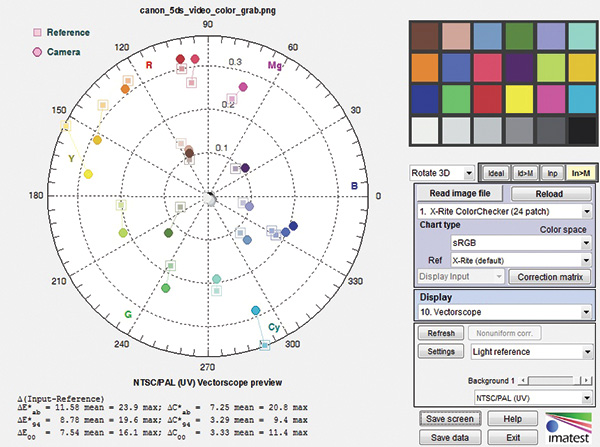
Comments On Video Quality
The Canon 5DS created high-resolution recordings of our test chart, which was reproduced with 910 lines per picture height, nearly the nominal resolution of Full HD videos (1,080 lines).
The color reproduction is very good. The camera showed an excellent performance when recording the test chart, results that carried into field recording quality. Skin tones are reproduced nearly perfectly and the saturation of and differentiation among all colors is very good.
Just as in photo mode, the noise results when recording videos is very good. The camera showed only minor noise artifacts even at ISO 3200 and ISO 6400. The dynamic range is very good (about 10 f/stops), but the camera sometimes reproduced high-contrast scenes with very hard contrast (high gamma).
Scorecard
Pros
› Full format sensor with extremely high image resolution (50.3MP)
› Excellent image results in resolution, sharpness, and color tests
› Excellent results in dynamic range test at lower ISO settings; very good results at higher ISO speed settings (ISO 800 and higher)
› Large optical viewfinder
› Very good video capabilities and video quality
Cons
› Wi-Fi functionality only with optional Wi-Fi adapter system
› Missing built-in flash
› Missing GPS system
› LCD monitor isn’t tiltable
The Canon EOS 5DS has a list price of $3,699 (body only). For more information, visit www.usa.canon.com.
(Lab Review is where we publish web-exclusive lab reports on cameras. To read more Lab Reviews, click on the Reviews tab on the top navigation bar of this page. New photo gear reports are published frequently, so check Reviews for more equipment evaluations from Shutterbug writers.)
- Log in or register to post comments

